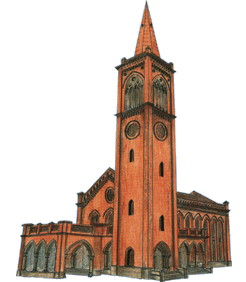
The synagogue was built 157 years ago and features a towering clock spire. The watchman tells us David Sassoon, who financed its construction, wanted the synagogue to be visible all across Pune, as indeed it was in its day.
The watchman himself is not Jewish, but has inherited the job of watchman from his father, and is clearly quite proud of the place. A Jew from Baghdad, David Sassoon was a major philanthropist, and built a hospital that stands to this day in Pune and bears his name. The mayor of Pune recently submitted a motion to remove the Sassoon name from the hospital and call it instead Dr. Ambedkar Hospital. The watchman tells us he had signed a petition protesting that initiative. My friend Kranti, though her family are followers of Dr. Ambedkar, tells him she too had written to protest that change. (The move was not particularly anti-Semitic, but rather part of a widespread move to rid Maharashtra of British names, and The mayor, when told of David Sassoon’s history, commented that she just thought he was British, and announced she was withdrawing her motion.)
Although Kranti has explained that I am a Buddhist nun from America, the watchman again whether I am Jewish, and it becomes clear that he would actually like to let us in. At last, he does, with a wave of his hand. We can walk around the grounds - but cannot enter the synagogue, he adds sternly.
We circle the synagogue. But for the stars of David, to my eye it looks an awful lot like a Gothic cathedral, right down to umatching ornamentation on the columns and long narrow stained glass windows.
As we come round the corner to return to the gate, we see a man and his wife enter on a scooter, and fear we may have gotten the watchman in trouble with our insistence. As we make for the gate, instead he calls us. The caretaker would like to meet us.
He opens the doorway, dons his yarmulke and invites us into the synagogue itself. We are inside an exquisitely detailed, almost understated synagogue in white marble with delicate, hand-painted trim, and all sense of Gothic cathedral disappears completely. The caretaker and his wife turn out to be long-standing members of the community and are most gracious in entertaining our questions. When I tell them I am from New York, his wife is full of questions about synagogues there. Are there really as many as she has heard? Do they offer Hebrew instruction? They are happy to answer our questions as well. The Jewish community in Pune now numbers 250 people, they tell us. Most are ‘Bagdadi’ Jews who migrated to India under British rule in the 18th century, but ten or so are Bene-Israel Jews, or Jews whose ancestors are said to have arrived in India before the destruction of the Second Temple in the first century of the common era. There had been several Jewish communities in Pune, but entire communities emigrated to Israel and now all the city’s Jews fit easily into this one space. They no longer use the separate section upstairs for women, but sit on opposite sides of the main floor during worship. All the high holidays are observed, as are services on the Sabbath, and weddings are still held in the synagogue itself. Rabbis visit, but none is resident, and there is no Hebrew instruction. Still, the foundation started by the Sassoon family continues with its charitable work, and now even has its own website - www.jacobsassoon.org - they tell us with some pride.
When it is time to leave, mindful of the watchman’s position, we make sure they know that he was very careful about letting us in, and did so only after long conversation. The caretaker tells us he used to open the synagogue for visitors for several hours one morning a week, but now will not even talk to journalists inquiring into the program. In 1990, in the opening days of the Gulf War, protestors broke into the synagogue and set fire to it. The Torah was burned, he tells us, with obvious distress. After that, they built the wall, and began to turn visitors away at the gate. Our visit ended, we return to that gate, and are treated to a broad grin from the watchman as we thank him and bid him goodbye.

6 comments:
Your post is very useful and interesting. I liked it very much and felt beneficial for all, if they have any doubt about the above mentioned topic. We can learn some valuable tips from this blog. You can have a look on my android apps development forum, I would be waiting for your valuable response. Thanks in advance.
Thanks for sharing above information! I really appreciate this post. I would like you to create many posts with new topics on this blog. - Dog Buy & Sale Classified
Amazing & true facts!!!
http://www.dog-buy.com/
Post a Comment